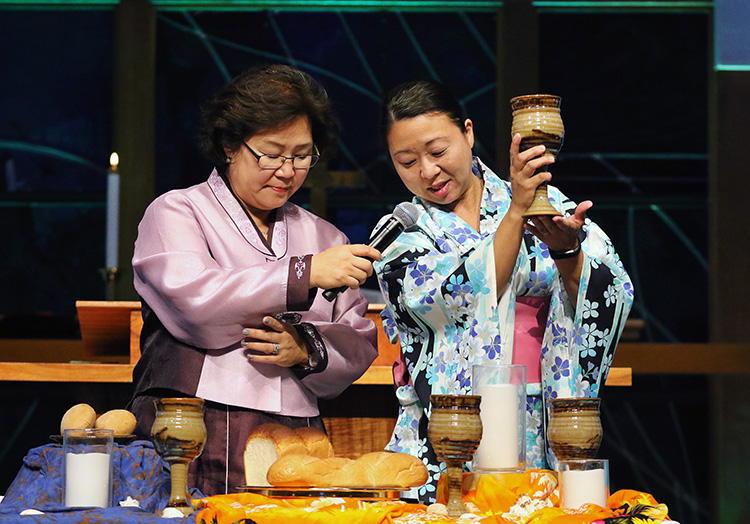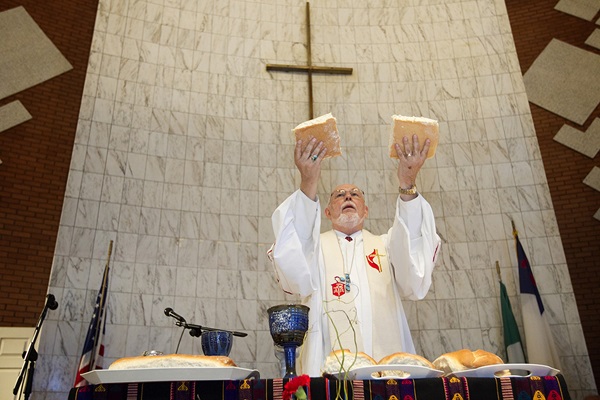What belongs on the Lord’s table? The short answer to the question is: “Whatever is needed for the celebration of the sacrament of Holy Communion, and little or nothing more.”
So, what is needed for the celebration of the sacrament?
Necessary items on the Lord's table
Some are obvious. You will need items that hold the bread and cup(s) and something to cover them, except during use.
For the bread, if you are using a loaf or large wafer, you will need a plate for the bread and a cloth to cover it. If you are using tray sets that include pre-cut elements, they usually come with a lid. The same is true if you use wafers and place them in a ciborium (a container for holding communion wafers). You may choose to add an additional cover if you use either, but the lid is already a cover.
For the grape juice or wine, you will need a chalice and something to cover it. You may also want to provide a separate pitcher filled with wine or grape juice in case the chalice runs out. If the pitcher is already covered, you need nothing further to cover it. Again, if you are using a tray set, the lid is a cover, so no additional covering is needed.
You may also want to provide something to hold the ritual the presiding pastor uses to lead the Great Thanksgiving. As a practical matter, even if you project these words on a screen where the presider can see them while facing the congregation, it is helpful to have a printed version on the table as a backup. We all have experienced technology glitches at the most inopportune times.
Customary and useful items on the Lord's table
Some items on the Lord’s table are customary but not strictly needed. Many United Methodist churches use paraments for the Lord’s table, the pulpit and, if they have one, a lectern. The paraments usually display the color of the season of the Christian year, such as Lent (purple), or special days, such as All Saints (white or gold).
Also customary is the use of a white linen to cover the top of the Lord’s table, particular directly under the elements. Most paraments are constructed so that they cover the top of the Lord’s table with plain white cloth. If you use a glass or plexiglass cover to hold the parament onto the table, there is no need to use additional white coverings on top of it, though you may.
Over the years, we’ve gotten many questions from people who wonder whether the entire Lord’s table is to be covered in white cloth when communion is celebrated, essentially replacing or even covering the parament for the season or day of the Christian year. The answer is no. The “fair white linen” historically covers all or part of the top of the table to provide a place for the elements that signifies purity. This can be as small as a white linen cloth, called a corporal, which can be sized to fit the elements in the form you use them. It is typically in the form of a square, like an unfolded white napkin, 18-24 inches on a side.
Also customary in many places are two large candles, one at either end of the Lord’s table. Historically, candles and other items not strictly needed for the celebration of the sacrament were not typically placed on the Lord’s table but on pillars or tables to the side of or behind the Lord’s table. However, it remains a custom in some traditions to do so. As long as they do not impede sightlines, candles can be a way to reinforce a sense of the holiness of what we do at the Lord's table.

What are some things that do not belong on the Lord’s table? From a practical standpoint, anything that is not needed for the celebration of Holy Communion and that would be in the way or blocking the sightlines of either the people or the presider.
A standard "altar set" sold by Protestant church supply houses throughout the 20th century was a case in point. It comprised two large candles, a large Bible and a large bronze or brass cross on a stand. The candles can be placed at the ends of the table without getting in the way of the presider or blocking sightlines. The large Bible and the cross, however, are another story. Neither is needed for the celebration of the sacrament. And both can get in the way or block sightlines. They also send a confusing message about the purpose of the Lord's table more as a display table than as the place set apart for the celebration of the sacrament of Holy Communion.
A large Bible is better placed on a lectern where it may be used for reading the scriptures rather than displayed and unused. If your congregation has a processional cross or, as many do, a large cross suspended above the Lord’s table or attached to a back wall, there is also no need for another one on the Lord’s table.
What about flowers? Are they needed for the celebration of the sacrament? No. Might they get in the way of sightlines when communion is celebrated? Yes. Flowers are better placed on side tables or a display area behind the Lord’s table.
So, what belongs on the Lord’s table? It is what is essential for the celebration and whatever is customary and potentially useful for, but not detracting from, the celebration of the sacrament.
This content was produced by Ask The UMC, a ministry of United Methodist Communications.





